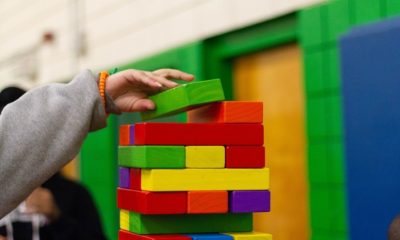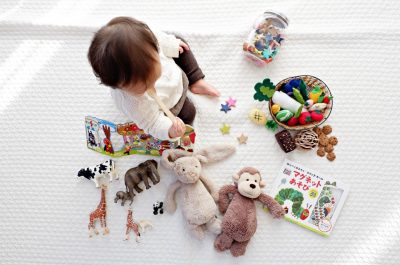By Samanta Rivas-Argueta, University of Toronto occupational therapy student
Edited by Lizette Alexander OT Reg. (Ont) with appreciation
Welcome to our new series titled: “A Child’s Occupations”. Over the next four weeks, we will be discussing various occupations your child may engage in. As a parent, you are probably thinking: “Occupations? My child doesn’t have a job!”

Let’s start by exploring what occupation really means for you and your child. As an adult, we engage in a variety of occupations; we work, we raise our
Occupations are life’s building blocks.
children, we engage in hobbies, etc. These occupations keep us busy, but most importantly, they give us meaning and purpose in life. But, what about our children? What are their occupations? What makes their lives meaningful?
Simply put, a child’s occupations are the daily activities they engage in. A child participates in all different kinds of occupations throughout the day, including eating, toileting, learning, playing, etc. These occupations are essential to a child’s development and ensure they become independent adults in the future.
WHY ARE OCCUPATIONS IMPORTANT?
Occupations are important because they impact health and well-being, provide a sense of justice, foster meaning and purpose in life, and shape one’s identity.
HEALTH
Occupational engagement and participation provide many health benefits; they enhance physical and cognitive functions, improve mental health, and contribute to health promotion and disease prevention. With that said, occupation has therapeutic potential, meaning occupations can help our children gain and restore health.
(World Federation of Occupational Therapists, 2010).
WELLNESS
Engaging in occupations helps us met our well-being needs, such as taking care of oneself, nurturing feelings of self-worth and competence, and fostering a sense of belonging within one’s family and community. Also, the ability to do things independently and choose what we want to do helps us be more productive and content.
(Hammell, 2004)
JUSTICE
Being able to engage in occupations that are meaningful to us makes people and communities thrive, become empowered and move towards social justice. Therefore, it is important to promote the right for everyone, including our children, to have equitable occupational opportunities and choices.
(Townsend, 1993).
MEANING
Being able to do what makes us happy is essential to making life meaningful. For example, a child who loves music may enjoy learning an instrument or learning to dance, not merely because they are able to do it but because “doing” music brings about new way to cherish life.
(Hammell, 2018)
PURPOSE
With the right occupational opportunities and abilities, a child gains hope and strive to engage in different life occupations, like riding a bike or do a cartwheel. This hope allows them to create goals and be motivated to achieve them.
(Hammell, 2018)
IDENTITY
DOING directly impacts one’s BEING. It’s what makes us who we are. For instance, being parents involves doing many things; we have to change diapers, teach life lessons, cook meals for our children and provide for them. These activities are fundamental to who we are. The same can be said for our children. What makes them who they are is namely what they do on a daily basis. Children are occupational beings.
(Canadian Association of Occupational Therapists, 2016)

Occupational therapy (OT) help children develop the skills for the job for living.
The goal of OT is for a child to engage in meaningful occupations. These occupations can be very specific, such as shoelace tying, or broader and more complex occupations, such as socializing with others at school.
An OT works together with the child and the parents/caregivers to determine occupational goals and treatment plans that focus on increasing engagement and participation in those occupations. The OT can also identify which underlying skills the child may need to work on in order to perform these occupations.
In general,
“Occupational therapy enables a just and inclusive society so that all people may participate to their potential in the daily occupations of life.”
Townsend & Polatajko (2007)
Although some children may learn to perform life daily occupations fairly easily, others may need more help. Children and teens who struggle to learn, initiate and complete a task, may benefit from additional support and practice. Common difficulties may arise from;
- difficulties with learning the steps of a task (motor planning),
- reduced fine motor and/or gross motor strength,
- difficulties with paying attention and/or redirecting attention,
- sensory avoidance or sensory seeking behaviors,
- altered visual perception,
- other
(KidsHealth, 2020)
This table displays some of the occupations and underlying skills that OTs focus on to help children reach their occupations goals.
AREA OF FOCUS |
SKILLS |
OCCUPATIONS |
|
|
Fine motor |
Fine motor skills involve small-muscle movements made with the hands and fingers. It includes finger dexterity, wrist and forearm control, and hand strength. |
 |
Grasping, printing, cutting, typing, drawing, turning pages, holding objects, buttoning clothing, shoelace tying, etc. |
|
Gross motor |
Gross motor skills involve large (core stabilizing) muscles of the body to achieve balance and body coordination. |
 |
Standing, walking, running, jumping, sitting upright, throwing, catching, etc. |
|
Cognition |
Cognitive (thinking) skills are those needed by the brain to help think, learn, remember, reason and pay attention. |
 |
Remembering letters, shapes and sequences, paying attention in class, challenging fears and other negative or automatic thinking patterns, etc. |
|
Sensory processing |
Sensory processing skills are needed to receive and respond to sensory information from the environment in a meaningful way. |
 |
Responding to light, touch, sound, smell and taste when feeding, toileting, playing, etc. |
|
Self-care |
Self-care tasks are activities you do every day to take care of you. |
 |
Dressing, bathing, self-feeding, toileting, etc. |
|
Visual-perception |
Visual-perceptual skills are required to make sense of what you see. |
 |
These skills are important when reading, doing puzzles, copying images, matching and sorting, etc. |
|
Social |
Social skills help you interact and communicate with others in social settings. |
 |
Taking turns to talk, listening and following directions, eye contact, respecting personal space, sharing, etc. |
Table developed by using the following resources; KidsHealth (2020); LearningRx (n.d.); WebMD (n.d.)
GENERAL TIPS TO ENABLE A CHILD’S OCCUPATIONS
Here are some general tips that you, as a parent and/or caregiver, can use to help your child participate in daily occupations;
- Make sure the task is meaningful for the child – the child will be more motivated to do it.
- Consider learning styles – Children learn differently, either by doing (kinaesthetic), watching (visual), and/or listening (auditory).
- Break down a task into manageable chunks – The child will be able to complete smaller tasks and develop self-efficacy.
- Use visual aids and checklists – These prompts will help the child remember the steps of the activity.
- Model the activity – When you model how to do the activity, the child may have a better understanding on how to do it.
- Consider the environment – The environment may impact the child’s ability to participate.
(Specialist Children’s Services, n.d.)
HOW THE TORONTO CHILDREN’S THERAPY CENTRE CAN HELP
In summary, occupations are the building blocks of a child’s life and need to be addressed. In this blog, we encourage you to look at a child’s life as a series of occupations they want and need to do. Consider how these occupations impact your child’s health, well-being, sense of justice, meaning, purpose and identity. Whether it be toileting, feeding or playing, these occupations are not always easy to perform and may require the help of occupational therapists (OTs). The OTs at TCTC can help children develop skills to enable participation and engagement in meaningful occupations.
Please contact us if you have any questions regarding your child’s performance in certain occupations and learn how OTs can help your child reach their occupational goals. For more information, visit the TCTC website to learn about our available OT programs.
References
Canadian Associations of Occupational Therapists. (2016). What is Occupational Therapy. Retrieved from: https://caot.ca/site/aboutot/whatisot_test
Hammell, K. W. (2004). Dimensions of meaning in the occupations of daily life. Canadian Journal of Occupational Therapy, 71, 296–305. doi:10.1177/000841740407100509
Hammell K. W. (2018). Opportunities for well-being: The right to occupational engagement. Canadian Journal of Occupational Therapy.
https://doi.org/10.1177/0008417417734831
KidsHealth. (2020). What is occupational therapy. Retrieved from:
https://kidshealth.org/en/parents/occupational-therapy.html
LearningRx. (n.d.). What are cognitive skills? Retrieved from: https://www.learningrx.com/what-is-brain-training-/what-are-cognitive-skills-/
Specialist Children’s Services. (n.d.). General Occupational Therapy Hints and Tips. Retrieved from: https://www.nhsggc.org.uk/media/249147/occupational-therapy-general-hints-and-tips.pdf
Townsend E., Polatajko H. (2007). Enabling Occupation II: Advancing an Occupational Therapy Vision for Health, Well-Being & Justice Through Occupation. Ottawa, Ontario, Canada: Canadian Association of Occupational Therapists.
Townsend, E. (1993). Occupational therapy’s social vision. Canadian Journal of Occupational Therapy, 60, 174–184. doi:10.1177/000841749306000403
WebMD (n.d.). Sensory Processing Disorder. Retrieved from: https://www.webmd.com/children/sensory-processing-disorder#1
World Federation of Occupational Therapists. (2010). Statement on occupational therapy. Retrieved from http://www.wfot.org/ResourceCentre.aspx
